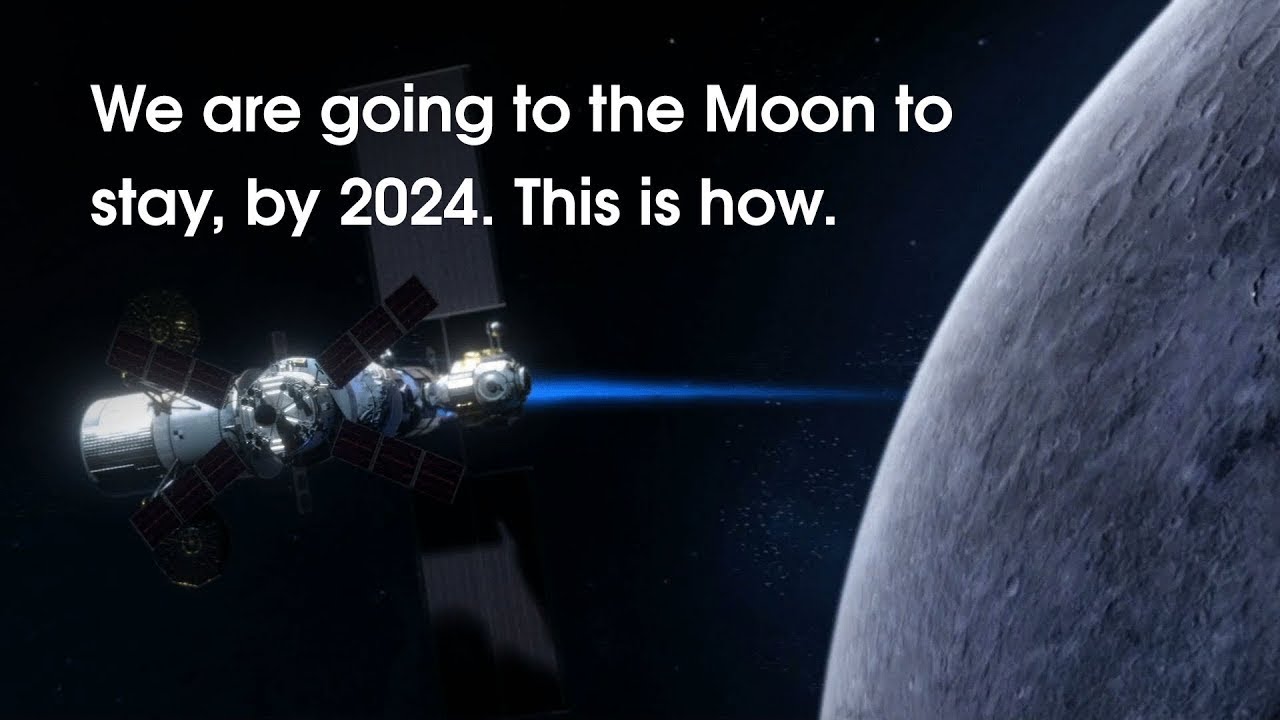Interview space
Life on the
moon - and beyond
NASA's human lunar exploration director on the mission to take humans into deep space
Marshall Smith was five years old when Neil Armstrong left humanity’s first boot print on the surface of the Moon. Now, as director of NASA’s human lunar exploration programme, Smith is at the heart of a mission to send humans back to the Moon and beyond. Here he tells Rob Scammell about the next giant leap for mankind.
NASA’s last human presence on the Moon was 47 years ago. But in 2024 that is set to change, with the agency’s commitment to putting the next man – and first woman – on the lunar surface. This time, says NASA, it’s to stay.
A lot has changed in in that time. In the 1960s, America’s highly ambitious moonshot was fuelled by its political rivalry with the Soviet Union, which saw billions of government money pumped into the programme to get ahead in the space race.
“Our mission was to put boots on the Moon and be first, and that's not our mission now,” says Marshall Smith, director of NASA’s human lunar exploration programmes. “Our mission is to go to the Moon and stay, have a sustained presence, and to continue moving forward into deep space.”
Creating a sustained presence on the Moon is seen as a vital next step in the mission to travel to Mars and beyond. But for that to happen, humans will first have to learn how to live for long periods on another astronomical body, testing new technologies and carrying out experiments.

Marshall Smith, director of NASA’s human lunar exploration programmes. All images and videos courtesy of NASA.
Safer landing systems
At the most dramatic moment of the Apollo 11 mission, Neil Armstrong was forced to pilot the lunar module around a gigantic boulder during the final descent. The alternative route took him over a gaping crater, all as the fuel levels reached dangerously low levels.
Advances in landing systems mean that the Artemis missions should be able to avoid such hair-raising moments, with an emphasis being placed on “precision landing”.
“We're going to develop a new landing system, it'll be a lot more advanced than Apollo. Your Apple watch or phone has more smarts in it than Apollo had,” says Smith.
Advanced avionics, improved cryogenic fuel tanks, autonomous systems and remote operated robots are other innovations that weren’t around 50 years ago, but will all play key roles in the next generation of space exploration.
Artist rendering of the Artemis project's lunar landing system.
Next-generation spacesuits
Part of the mission to put people on the moon involves designing suits that allow them to be more mobile in space. The spacesuits worn by the likes of Buzz Aldrin and Alan Shepard during the Apollo missions were cutting-edge – but they were cumbersome.
“The first time you see astronauts bouncing around and doing the bunny hop thing. That's because they couldn't bend; it's like inflating a balloon,” explains Smith, who spends much of his time providing strategic updates to NASA leadership and the White House.
But with 50 years of experience from doing spacewalks, NASA has made a range of improvements for the suits that will be worn during the Artemis missions. Officially called Exploration Extravehicular Mobility Units, or xEMUs, the suits will protect astronauts from the vacuum of space while allowing a greater range of movement.
“Our suits will have new technology that will actually have articulated joints, to be able to move and bend normally. That'll be a big, big improvement,” says Smith.
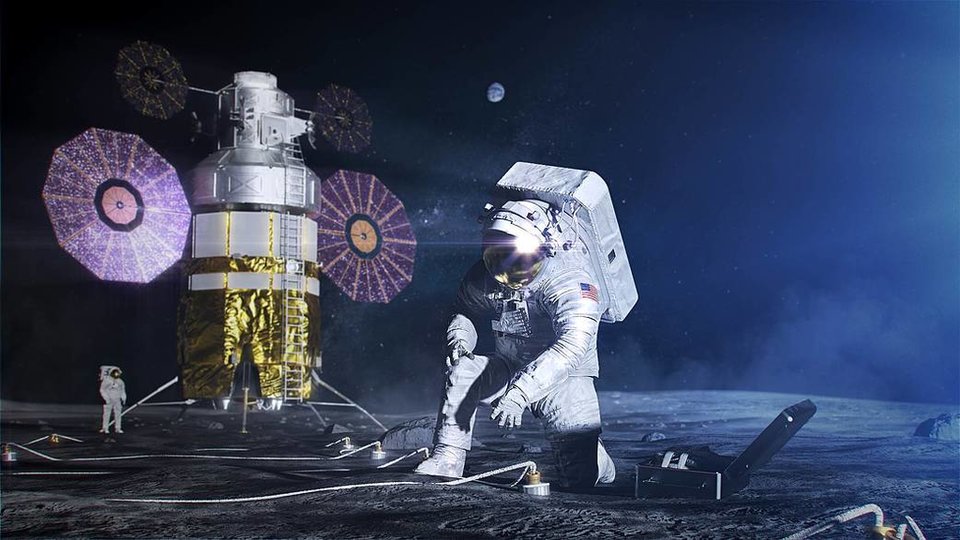
Artist concept of an astronaut in the xEMU space suit setting up a science experiment on the lunar surface.
New tech for lunar explorers
With the help of these new technologies, lunar explorers will be able to conduct more research than was previously possible.
“The Moon is extremely interesting to us,” says Smith. “Back when Apollo went, you know, we didn't even know whether Apollo would sink and disappear under the dust.”
Nowadays scientists have a much deeper understanding of the Moon. For instance, we now know that there’s water ice on the Moon, which could prove to be a vital resource for future inhabitants.
“
During the height of the Apollo missions NASA’s budget represented 4.41% of federal spending. Now, its just 0.49%."
It is widely accepted that the Moon was once part of Earth, a by-product of a colossal collision with a Mars-sized rock some 4.5 billion years ago. As a result, there’s an abundance of minerals and rare elements that, some say, could one day be mined, creating an entirely new lunar economy.
Commercial partners are also playing a role in the Artemis programme. During the height of the Apollo missions NASA’s budget represented 4.41% of federal spending. Now, its budget is $21.5bn – just 0.49% of government spending.
Filling the funding gap are Elon Musk’s SpaceX and Jeff Bezos’ Blue Origin, among others. Such partnerships allows NASA to outsource resupply missions and new technology development, from lunar landers to re-usable rockets.
This video sets out NASA's plans to return to the Moon in 2024.
A giant leap for womankind?
During the Apollo mission, women played a key role behind the scenes, working as mathematicians or human ‘computers’ at NASA. Yet no woman has ever set foot on the Moon. With Artemis – named after the twin sister of the Greek God Apollo – that is finally set to change.
NASA administrator Jim Bridenstine has hinted that it could be two women, as opposed to just one, going on the first return mission. While Smith is not involved in selecting the Artemis astronauts, he says it’s “certainly likely” that it could be two women.
“We're going to be landing the first woman astronaut on the south pole of the Moon in 2024 and maybe even two women – we don't know yet,” he says. “But certainly one, for sure.”
Smith is also keen to point to other “key women in key places”, such as the programme manager for NASA’s human landing system Lisa Watson-Morgan, and Lara Kearney, the deputy programme manager of the Gateway programme.
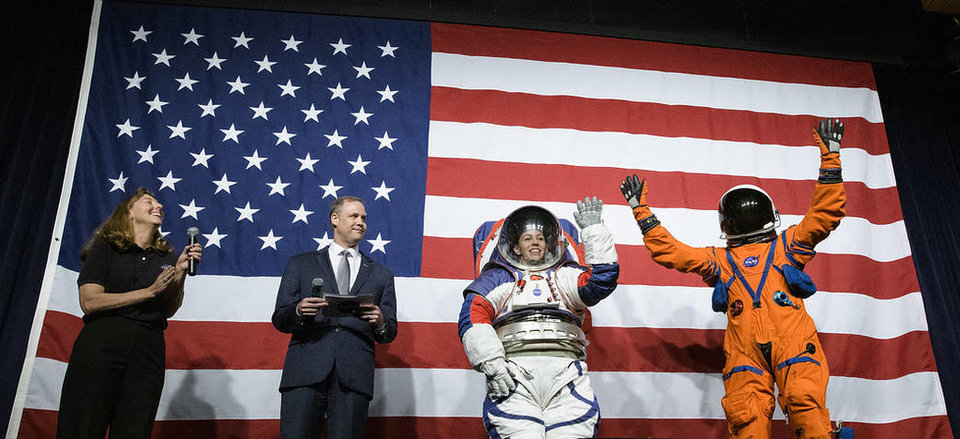
Left to right: NASA spacesuit engineer Amy Ross and NASA administrator Jim Bridenstine present the latest generation spacesuits. NASA spacesuit engineer Kristine Davis wears a ground prototype of the xEMU, and Dustin Gohmert, NASA's Orion crew survival systems project manager, wears the Orion Crew Survival System.
Tracking missions with high-quality data
The footage of Neil Armstrong descending from the lunar module is certainly one of the most iconic moments captured in human history. But for all its dramatic awe, the pictures were grainy and monochrome – shackled by the camera technology of the time.
Nowadays, cameras are far superior and advances such as virtual reality, 360-degree cameras and ultra-HD have changed the way researchers collect data and people consume media. Can we expect to see advanced video technologies deployed to document the next mission in 2024?
“Absolutely,” says Smith. “Video is part of our data that we look at. It's not just about entertainment; it's really about knowing what's going on in the mission and how it's moving forward. Super high-quality images will be key. The rate that video progresses between now and 2024, I don't even know what the name of that capability will be. But I expect that we'll be using the best capability that we have available to us on those missions.”
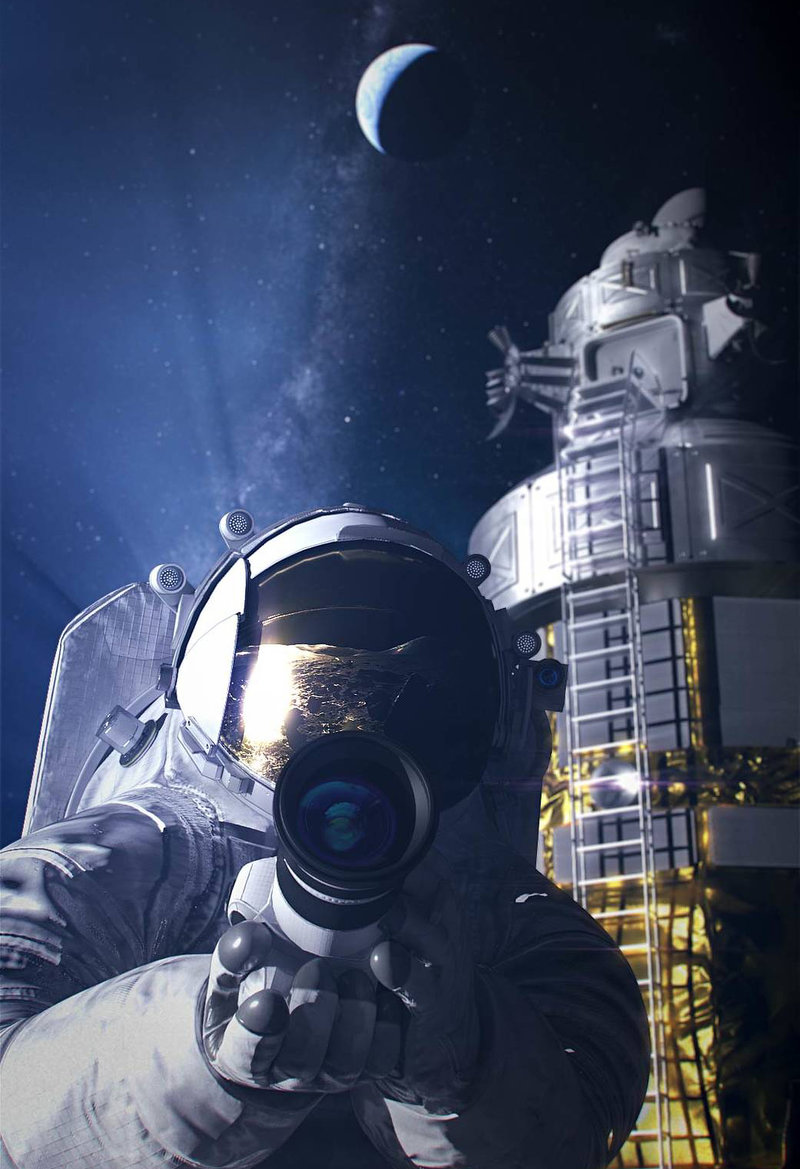
Artist concept of an astronaut in the xEMU space suit taking photos on the Moon.
"You're going to get some good pictures out of this for sure."
The Gateway lunar outpost – a small hub for astronauts and supplies that will orbit around the Moon – will also play a key role in returning that data back to Earth with as little delay as possible.
“Maybe we’ll even eventually have optical [communications] capabilities that will really get the bandwidth up so we can get a lot of this data back in real time, super high-res data. So you'll get some good pictures out of this for sure.”
Artist rendering of a Gateway lunar outpost circling Moon's orbit.
On track for 2024?
The primary launch vehicle for the Artemis programme is NASA’s Space Launch System. The super-heavy expendable launch vehicle is currently under construction, but delays have seen the first test mission pushed back.
Artemis 1, the second planned uncrewed test flight, is currently scheduled for mid-2020. Is Smith worried that further delays will affect the launch date of Artemis 3, the first crewed return mission?
“So my goal and my requirement on that side of the programme is that we test the systems out appropriately, we make sure they're ready for the Artemis 3 flight 2024,” he says. “How that comes out, whether it's 2021 or 2022, how those work out with those two launch dates, I'm not really concerned as long as we keep Artemis 3 on track.”
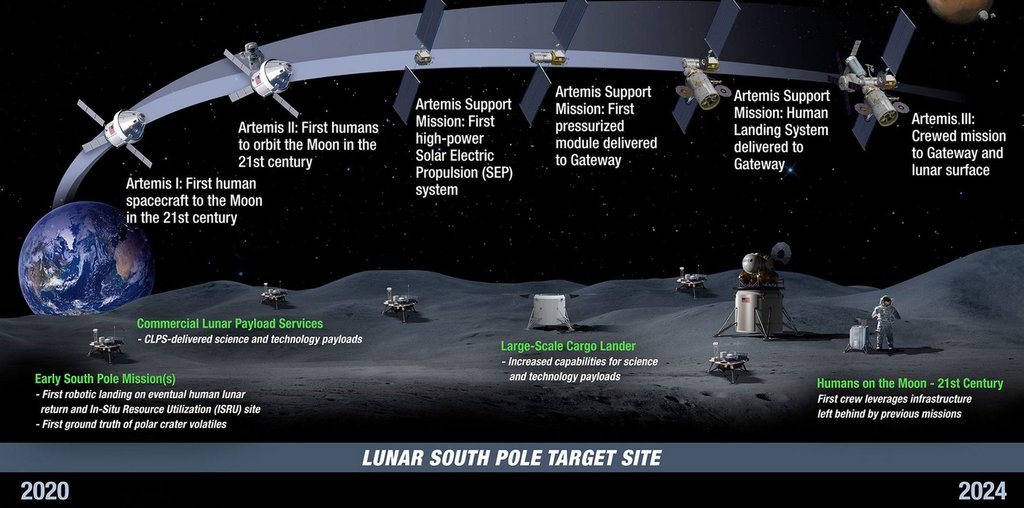
The timeline for the three phases of NASA's Artemis project.
Critics have also raised other concerns about the 2024 target. In a recent op-ed for Space News Doug Cooke, the former associate administrator for NASA’s Office of Exploration Systems Mission Directorate, said that NASA was taking too much on with Gateway and the Artemis missions.
“The Gateway is arbitrarily imposed and is slowing America’s progress back to the Moon,” he wrote, adding that NASA should “streamline” and stick to tried and tested methods to meet the 2024 deadline.
But Smith disagrees. "Certainly you want to focus on your goals, but you can't forget the long-term horizon,” he explains.
“
The Gateway enables lunar architectures, to allow us to have multiple launch vehicles available to us, allows us to split up the delta V – that's the energy required to go to different parts of the universe or solar system."
The Gateway is going up in two pieces: the Habitation and Logistics Outpost (HALO) and the Power and Propulsion Element (PPE). Smith points out that these elements are being launched commercially via fixed priced contracts.
“So you know, for somebody to say we're mixing up our priorities and our complexity, we're making this harder, we're actually enabling,” says Smith.
“The Gateway enables lunar architectures, to allow us to have multiple launch vehicles available to us, allows us to split up the delta V – that's the energy required to go to different parts of the universe or solar system. So we can split up the delta V to different orbits. And it actually gives us a lot more players and more players actually increases competition, which actually helps us on scheduling costs dramatically.”
He says that once Gateway is complete it will enable greater international cooperation for supplies, adding: “I don't believe we have mixed priorities up at the expense of the Moon and I believe we're enabling capability actually.”
"There's a lot of similarities between the Moon and Mars so we can actually test a lot of our systems out and get operational experience with them."
The aim of the Artemis project is to pave the way for missions to Mars and beyond.
Life on Mars: setting sights on deep space
All of these elements involved in the Artemis mission – technology, science, personnel and infrastructure – are leading towards NASA’s “horizon goal”, its next giant leap: Mars.
It is a challenge of cosmic scale: at its closest orbit, Mars is 33.9 million miles from Earth. The Moon is 238,900 miles.
“We want to learn how to live and operate in deep space. Right now, when we’re at a low Earth orbit, we are roughly 40 minutes away from being back on the surface of the earth,” says Smith.
With the Moon, it’ll be days away. With Mars, it’ll be years. That means astronauts will be limited by the amount of resources they can take with them, and constrained by how quickly extra supplies can be sent. They will have to learn how to use the resources available and adapt to the different environment on the red planet.
The Moon, says Smith, is the perfect testing ground for that. “There's a lot of similarities between the Moon and Mars so we can actually test a lot of our systems out and get operational experience with them,” he explains.
Over the years NASA has sent four robotic vehicles to Mars. But landing a craft carrying a human crew makes those missions a breeze by comparison.
“A lot of people don't realise the biggest thing we've landed on Mars is about a one and a half metric tons. And that was seven minutes of terror,” says Smith, referring to the intricate ‘sky crane’ manoeuvres used to land NASA’s Curiosity rover in 2013.
“
Where are humans going to 100 to 400 years from now? Are we going to be living all over the solar system? I would like to see that."
And the challenge doesn’t stop at getting to Mars. Once there, humans will need to live in an unforgiving environment, exposed to higher levels of solar radiation and large temperature swings.
“We need to learn how to live, be self-sufficient in deep space, how to operate systems, how these systems will perform in deep space in the radiation environments that they're in and those types of things before we actually take off and go to Mars,” says Smith.
Given all the complexities, Smith estimates it’ll be in the late 2030s that humans set foot on the red planet. “It's not going to be easy,” he says. “But you know, if it was easy then everybody would do it.”
Smith, who has childhood memories of astronauts “bouncing around on TV” during the Apollo missions, is excited that humanity is edging closer to taking its place in the stars.
“What excites me is that humanity is actually taking the step that I wanted them to take, to step off the Earth with an intent to stay and go into the solar system,” he says. “Where are humans going to 100 to 400 years from now? Are we going to be living all over the solar system? I would like to see that. It excites me that I'm part of the first steps to do that.”
